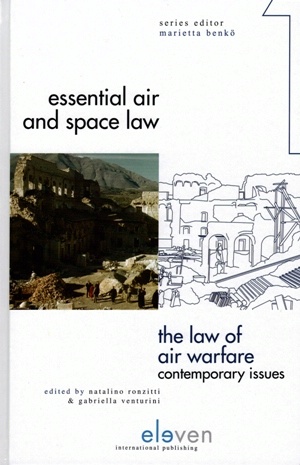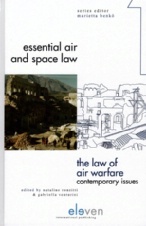Eleven International Publishing
Essential Air And Space Law - SERIES EDITOR: MARIETTA BENKÖ
Natalino Ronzitti & Gabriella Venturini (eds.)
THE LAW OF AIR WARFARE
CONTEMPORARY ISSUES
This book is the outcome of a joint research project, which took place under the auspices of LUISS University (Rome) and the University of Milan. The project explores the current status and future prospects of international humanitarian law of air warfare. This is achieved through the analysis of international customary law, the conventional provisions in force and the most recent State practice, covering air operations in Iraq, Afghanistan and the Federal Republic of Yugoslavia.
This book clarifies the most contoversial issues concerning the law of air warfare and, thus, fills a gap in existing legal literature.
Excerpt PART IV - CASE STUDIES
Christian Ponti
Air Operations against Afghanistan (2001-2002)
1. Overview of the air campaign in Afghanistan and applicable international humanitarian law
The military air campaign in Afghanistan, named "Operation Enduring Freedom" (1), began on 7 October 2001, in response to the 11 September 2001 terrorist attacks against the United States. The air campaign was driven by a coalition of States, led by the United States, (2) against the Al Qaeda terrorist group and the Taliban Régime in Afghanistan.(3) The political and military objectives of Operation Enduring Freedom included the destructions of Al Qaeda infrastructure and terrorist training camps within Afghanistan, the capture of Al Qaeda leaders, the cessation of terrorist activities in Afghanistan and the removal of the Taliban Régime.(4)
From 7 October 2001 until the end of March 2002, the US-led coalition aircraft dropped about 21,000 air munitions over Afghanistan. (5). Initial combat operations included a mix of strategic air strikes on fixed military targets such as military bases, airfields, terrorist training camps and communication facilities from land-based B-1, B-2 and B-52 bombers; carrier-based F-14 and F/A-18 fighters; and Tomahawk cruise missiles launched from both US and British ships and submarines. These attacks were followed by weeks of tactical air strikes on moving targets and command-and-control activities. On October 19, a small number of US ground troops were deployed to help and to coordinate air strikes with Afghan forces. (6) With help from the skies, these anti-Taliban forces fought their way toward the country's major urban centres. On November 9, Mazar-e-Sharif became the first Afghan city to be released from the Taliban's grip. In succeeding days, Taloqan, Herat and Shindand were liberated, followed by Afghanistan's capital city Kabul and Jalalabad. Kunduz and Kandahar, the last Taliban strongholds, fell on November 25 and December 7, respectively. Afterwards the coalition forces moved to the Afghanistan caves in the Tora Bora mountain region where Taliban and Al Qaeda leaders were thought to be hiding. During the whole air campaign there had been no relevant Afghan air and anti-aircraft activities.(7)
Pursuant to an agreement reached in Bonn, the ad interim Chairman Hamid Karzai and the new western-friendly government of Afghanistan took office on December 22. (8) By mid-March 2002, the Taliban had been removed from power and the Al Qaeda network in Afghanistan had been dismantled for the most part. To date Operation Enduring Freedom is still ongoing with coalition forces continuing to locate and destroy Taliban pockets of resistance (which still seem to control some parts of the country) and Al Qaeda fighters and to search for signs of surviving leadership. (9)
This study will attempt to analyze the air campaign from the viewpoint of the obligations imposed by customary and conventional international humanitarian law on the jus in bello in the air campaign on Afghanistan, and the question of the legality of the use of force by the United States and coalition States against Afghanistan (jus ad bellum) is not considered. The jus in bello applies to all parties involved in a conflict, irrespective of the legality of the resort to force by either party. (10) The jus in bello applicable to the Afghan conflict is that applicable to international armed conflicts. (11) It encompasses the customary law of international armed conflicts, which applies to all the belligerents, and conventional international humanitarian law in force between States involved in the conflict. In this regard, the cornerstones of conventional international humanitarian law applicable to international armed conflicts are the four Geneva Conventions of 1949 and the Additional Protocol of 1977 Relating to the Protection of Victims of International Armed Conflicts (hereinafter Protocol I). (12) The United States and Afghanistan are parties to the Geneva Conventions, but neither the US nor Afghanistan has ratified Protocol I. The UK is party to the Geneva Conventions and has ratified Protocol I. Notwithstanding, recent US practice has shown considerable openness toward the application of the Rules of Protocol I. General Colin Powell, then Chairman of the US Joint Chiefs of Staff, made it clear in his Report to Congress on Coalition operations in the first Gulf War in 1991, that the provisions of Protocol I were, for the main part, applied as reflective of customary international law. (13) Respect for customary international humanitarian law was declared by the US during the Afghan air campaign too. (14)
Obviously, it is in any case necessary to carefully scrutinize the exact interpretation given by the US - in official statements and in practice - to the content of customary provisions relevant to the different aspects of the air campaign. This kind of analysis will be made in the course of the study.
The following part will focus on the main characteristics of the aerial bombardments in Afghanistan, raising issues such as target selection, application of the principle of proportionality, collateral damage and protection of civilians and civilian objectives. Air-to-air engagements, which are also relevant for the international law of air warfare, will not be examined as the issue did not create a particular problem in the Afghan conflict due to the low capabilities of the Afghan air forces. (15)
The third part will deal with the question of the legality of weapons used during the air campaign; and the last part will draw some conclusions.
(...)
4. Concluding remarks
In the era of globalization, information circulates fast and throughout the world thanks to media reports and telecommunication systems. The unprecedented circulation of information certainly plays a role in the growing interest of the international community surrounding the law of armed conflict in modern technological warfare. The demand to reduce to a minimum the number of human losses, both military and civilian, during a conflict has become an increasingly sensitive issue for decision-makers, as the call to States to respect the norms of international humanitarian law is not only a consequence of a legal duty, but also a moral obligation arising from the pressure of the public opinion of all democratic States.
In the era of information, democratic States are required by the international community to show transparency. From this study it emerges that beside the successful military air operations of the US-led coalition against Afghanistan during the campaign, there have been possible violations of international humanitarian law. Transparency about targeting choices would help to evaluate more precisely the process of selecting military objectives, technical failures or pilot errors. Access to confidential information could also be useful to assess issues such as collateral damage and proportionality more thoroughly. Last but not least, an open attitude to explain the policies guiding the choices in the selection of weapons employed in the different thatres of the war might help to better understand and to evaluate the use of dubious weapons such as cluster bombs, that tend to be indiscriminate when used in or near populated areas.
In any case, an open attitude before the international commmunity would be more consistent with the declared willingness of western States to respect international humanitarian law during modern conflicts, which is not properly expressed by silence.
PONTI, CHRISTIAN: Air Operations against Afghanistan (2001-2002), in: ESSENTIAL AIR AND SPACE LAW (SERIES EDITOR: MARIETTA BENKÖ), Volume 1: Natalino Ronzitti & Gabriella Venturini (eds.), The Law of Air Warfare - Contemporary Issues, Eleven International Publishing, Utrecht, the Netherlands 2006, p. 299-302;323-324.



